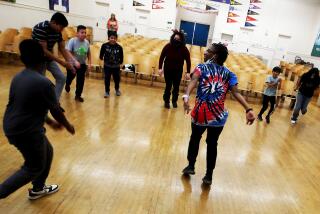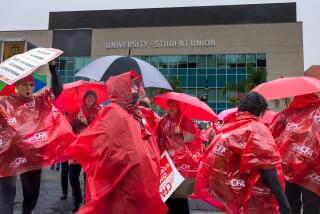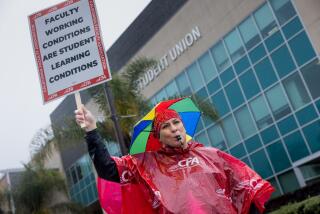LAUSD teachersâ strike ends. Teachers to return to classrooms Wednesday

Mayor Eric Garcetti announces that L.A.âs teachers union and school district have reached a contract agreement.
The Los Angeles teachers union ended its strike Tuesday night, based on overwhelming support for a contract agreement with the school district, union leaders said.
Teachers, nurses, counselors and librarians will be back in their classrooms Wednesday, said Alex Caputo-Pearl, president of United Teachers Los Angeles.
âA vast supermajority are voting yes for the agreement that we made,â said Caputo-Pearl, who also acknowledged that many votes still were being tallied.
âWe know what the results are going to be,â he said, at a news conference at union headquarters in Koreatown on Tuesday night.
It was a dramatic end to a dramatic day that started with Caputo-Pearl and L.A. schools Supt. Austin Beutner emerging from an all-night negotiating session at City Hall. The intense talks were mediated by L.A. Mayor Eric Garcetti and his senior staff.
Caputo-Pearl then moved across the street to a massive rally of teachers and supporters in Grand Park, where he hailed âhistoricâ gains in the fight for smaller classes and âfully staffedâ campuses.
The strike was an undeniable victory in terms of public attention and support and political momentum, but the contract that emerged was mixed when it comes to the changes that students, teachers and parents will see at schools next year.
And the vote was not the âno concessionsâ agreement that the union called it in a news release.
The tentative deal includes what amounts to a 6% raise for teachers â with a 3% raise for the last school year and a 3% raise for this school year.
But teachers also lost about 3% of their salary by being on strike for six days, according to the school district. Other employees got the same 6% raise without having to makes such a sacrifice. The district had offered 6% to teachers before they went on strike.
Striking teachers were sincere, though, when they said the walkout was always about more than salary. The broader concerns they voiced â about overcrowded classrooms and schools without nurses on hand to help when a student got hurt or fell ill â had a lot to do with why the public responded so warmly and cheered them on, bringing food to the lines and even bringing their children to march alongside the strikers.
For students who rallied and picketed, the strike was a real-life civics lesson, while students inside the thinly staffed schools were watching movies, doing online coursework or playing with cellphones.
Families identified in particular with teachersâ complaints about overly large classes, because class size affects them directly.
But in this area, the contract gains were modest compared with the unionâs rhetoric about what it would accept.
The agreement calls for a drop of one student per class next year in grades four through 12, one more the year after and two more the year after that. That final-year reduction, however, may not be set in stone. It could be contingent on new tax revenue, a district source told The Times.
A few classes could see bigger drops. If maximum sizes are enforced, some extra-large classes could lose five to 10 students immediately, Caputo-Pearl said.
Campuses targeted for special help â 75 elementary schools and 15 middle schools â will see their class sizes drop by an additional two students. The district has 1,240 schools.
It was not immediately clear whether L.A. Unified was putting more money into smaller classes than it had in its final offer before the strike began â which the union quickly rejected. It could be that the modest reductions proposed by L.A. Unified were simply replaced by different modest reductions that the union preferred.
The union did win on removing a contract provision that has allowed the school district to increase class sizes in times of economic hardship â which is something teachers very much wanted.
What would happen to classes in the future when the district was forced to make budget cuts was not explained, but Caputo-Pearl on Tuesday brought up how the district and teachers responded to the 2008 recession. That crisis led to layoffs, but unions and their members also agreed to unpaid furlough days to cut costs and save jobs.
The goal of the gradual reduction is to get back to class sizes that already were part of the contract that expired in 2017, the union leader said. Those class sizes didnât really exist in practice because the district used the economic hardship provision to make classes larger.
âWe have started down a real path to address class size,â Caputo-Pearl said.
The pact includes a commitment to provide a full-time nurse in every school, which is a real gain for nurses and students. Currently, the district pays for nurses one day a week at schools, although schools often use discretionary funds to pay for additional days.
The districtâs offer before the strike guaranteed full-time nurses only in elementary schools and only for next year. The new agreement, which runs through June 2022, pledges to maintain the added health services.
The deal also promises a librarian in every middle and high school. Up to now, these schools could choose not to have a librarian and to use that money for other things. Once again, the union got the district to extend this commitment for longer than one year.
The number of academic counselors at high schools will increase but students may hardly notice, with an âimprovedâ but still unwieldy student-to-counselor ratio of close to 500 to 1.
In the end, union negotiators could not change district officialsâ determination that L.A. Unified remains at financial risk moving forward. In the joint news conference to announce the agreement, Caputo-Pearl breezed past this question, saying that he and Beutner still had disagreements over some of the budget numbers.
Because of this, union leaders called attention to elements of the deal that are not big budget items, but that still matter to union members or have symbolic importance.
For example, the union has repeatedly raised alarms about the growth of privately operated, mostly nonunion charter schools, which compete with the district for students and the government funding that follows them.
Caputo-Pearl has called for a moratorium on new charters, and Beutner agreed to put forward a board resolution âcalling on the state to establish a charter school cap and the creation of a governorâs committee on charter schoolsâ at the next state Board of Education meeting.
The school boardâs resolution would have no binding effect on state rules regarding charters, and under state law, local school boards must approve all new valid charter proposals.
Charters also are entitled to space on district-operated campuses. On this front, the union and local teachers will get more information in advance and more of a say in how campuses are shared.
The district committed in the agreement to create 30 community schools â a model that has been tried in Cincinnati and Austin, Texas. These schools are supposed to provide social services to students and family, rich academic programs that include the arts and leadership roles for parents and teachers.
The district also agreed to expand to 28 the number of schools that will no longer conduct random searches of middle and high school students. That provision was especially important to students who marched in support of their teachers.
The union posted the full text of the agreement online. Both the union and the district also have posted summaries.
Some union members expressed disappointment with the results, including a Marshall High teacher who said that her room has 36 desks, but some of her classes have up to 40 students.
âI think itâs kind of sad that we had to spend six days getting the numbers that we already had,â she said.
An elementary teacher called the deal âmarginally better than what was rejected before the strike.â
âWe were only given three hours to review a 40-page agreement and return to our school site to vote,â he said. âI left my stomach-flu wife with my stomach-flu daughter to make my no vote. This agreement was not worth striking over.â
Teachers who voted no asked to remain anonymous out of concern about possible conflicts with colleagues.
But Brandon Abraham, who teaches at Hamilton High, called himself a âsolid yes.â
âNo agreement is perfect, and weâre back negotiating and fighting for students in no time,â he said.
Beutner, who had tried to stop the strike, said the job action had put an important focus on public education, beginning a community conversation.
âPublic education is now the topic in every household in our community,â he said. âLetâs capitalize on that. Letâs fix it.â
âWe canât solve 40 years of under-investment in public education in just one week or just one contract,â he said.
Throughout negotiations, district officials said the union demands were far more than the school system could afford.
Before it can take effect, the deal must be reviewed by the Los Angeles County Office of Education, which will report on whether it thinks L.A. Unified can afford the terms. The L.A. school board has scheduled a vote for Jan. 29. The boardâs approval is expected.
The long-term next step, both the union and the district say, is to harness the momentum of the strike to get voters and lawmakers to provide better funding for schools.
Schools were open on Tuesday, as they were last week â managed by skeleton staffs of administrators and employees who were not on strike. More than two-thirds of students did not show up during the first week of the strike, and attendance remained low Tuesday.
The final key details of the tentative deal were worked out during an all-night bargaining session that ended at 6:15 a.m.
The agreement was announced at a 9:30 a.m. news conference at City Hall by Beutner, Caputo-Pearl and Garcetti, in the same wood-paneled conference room where much of the back-and-forth had taken place.
No one had slept. For the news conference, Caputo-Pearl put on a suit jacket. Beutner put on a tie.
âToday is a day full of good news,â Garcetti said in announcing the agreement, which he said came after a â21-hour marathon that wrapped up just before sunrise.â
âEveryone on every side has worked tirelessly to make this happen,â the mayor said.
The union could have held out longer â and some insiders originally envisioned a longer strike. But public support, which has been strong, might have eroded if the effort dragged on.
The strike has made teachers realize âweâre a lot stronger than we thought we were, so now weâre not going to let things slide,â said Nancy De La Torre, a first-grade teacher at Corona Avenue Elementary School in Bell.
She said she knew that the union was not going to get everything it asked for.
âAt some point, youâve got to compromise,â she said.
Times staff writers Matthew Ormseth, Dakota Smith and Ruben Vives contributed to this report.
More to Read
Sign up for Essential California
The most important California stories and recommendations in your inbox every morning.
You may occasionally receive promotional content from the Los Angeles Times.












